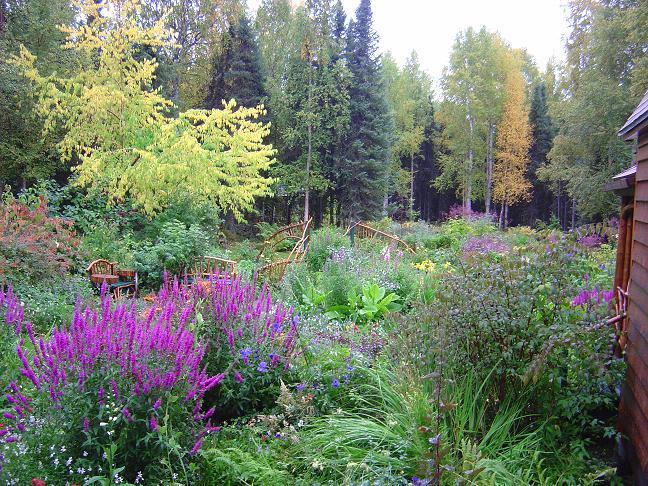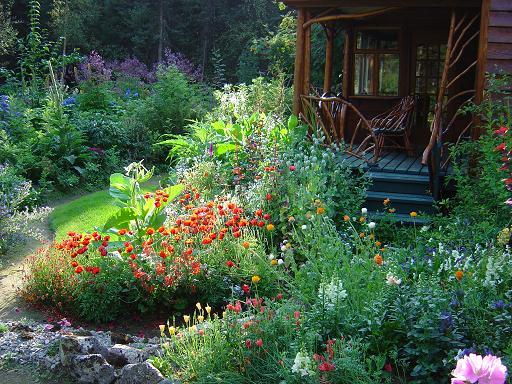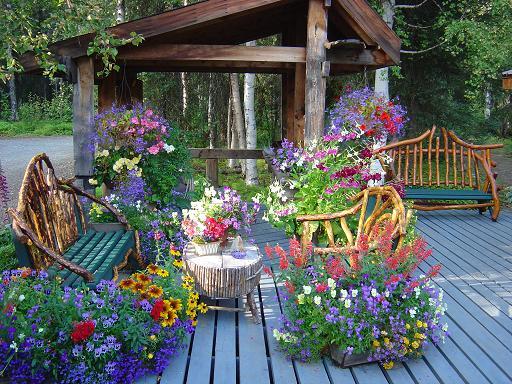Caught between the weather and wild animals, gardening in Alaska is an extreme sport. Yet, despite nine months of winter and roaming wild animals, Les Brakes' garden abundantly blooms from June to September.
Delphiniums and foxgloves skyrocket from 6 inches to 6 feet in a month to sway above Les Brake's June garden. Summer's galloping growth is the norm in Willow, Alaska, 70 miles north of Anchorage. By mid-July, delphiniums are 10-feet tall with enough blooms to spare and sprinkle along the path to the pond without depleting the stalks. Although Les says, "cool colors work better in the low angle of the northern sun," crimson is used as a wake-up call so the garden doesn't put you to sleep with its muted colors.
The rampant summer growth is caused by a combination of almost constant sunlight, cool 50-degree nights and warm - not hot - mostly 70-degree days. Alaskan gardens thrive from June to August, wedged between weather extremes. The coldest day in winter plunged to -55 degrees; the hottest in summer hit 90. That's a yearlong difference of 145 degrees.
In May the snow melts, and outdoor gardening - and the magic - begins here in Zone 2. As Les says, "It's snow to mow in a month and a far cry from the rough-and-tumbleweed Texas where I was born. I've loved Alaska ever since I first set foot here." After Les' first summer visit in 1980 he had to return home. But he said, "I remained haunted by the fresh, wild beauty of America's far-flung frontier until I was able to move permanently in 1984."
Les quickly discovered an Alaskan summer is drastically different from winter, with nine months of snow and ice. After the first winter, he was starved for flowers and color. As he recalls, "A love of gardening and flowers ran through my family." A crash coarse in gardening was a must. So a gardener in Anchorage got him started. Then, gardening, alone in a wilderness on virgin soil, Les learned by doing, clearing the land, growing most of his own flowers from seed, laying out the curvaceous beds and hand watering. He refers to his garden style as rustic romance. His partner Jerry Conrad crafted the rustic benches, trellises, and deck that link the garden to the surrounding forest.
"Alaska, which means the Great Land, demands great gardens," Les says, as explanation for why he persisted in gardening after major setbacks. During the 1995-96 "Blue Screamer," a winter without snow cover until February, the ground froze to a depth of 10 feet. Snow normally insulates the ground, protecting plants from deep freezes. During his first ten years, he says, "Despite thirty to forty nights below zero, with 129 inches of snow cover even lamb's ears come through green. That's the power of snow." Snowfalls average 110 inches and Les welcomes it to protect his plants and replenish Wood Frog Pond, where he fills his watering cans.
The deep freeze cost Les 2000 of his 2,100 bulbs and most of his perennials. In Alaska he realized, bulbs are "fancy annuals." The survivors, "winter proof perennials," were almost all from high altitudes--Himalayan blue poppies, Siberian iris, delphiniums and alpine primroses. They are garden staples. Many annuals reseed so readily they are "annual perenials."
From his losses, Les learned a hard lesson--allow magically hardy perennials to set and drop seed in case the mother plant dies, and grow more alpine plants. He also starts seed indoors in winter, for replenishing the garden and trying new plants each summer.
Devastating weather again depleted 70% of the garden in the winter of 2002-03 but Les was ready. He had upped his insurance by saving the seedheads of annuals and perennials.
Weather is only one of the challenges, wild animals another. Black bears, grizzlies, wolves, foxes, moose, coyotes, and porcupines are frequent visitors emerging from the woods to trample and munch in his garden. One winter, rabbits ate the tops off of his 9-foot high maple trees. Covered with 6-feet of snow, the treetops are at ground level.
Bear are a real danger. Strangely, house cats are Les' attack alarms. "The old Siamese stands straight up if a bear is here. She really did save me from a black bear that might have attacked me had I not been alerted to its approach," he said. "I accidentally splashed a solution of fish emulsion all over myself and a big black bear thought he'd detected a 160-pound land salmon."
Yet, nothing deters Les. Asked if it is all worth it, Les replies, "I could happily garden here for many more years...While most of the states are withering and wilting under the summer sun, Alaska's gardens are sweet and lush with overblown abundance."


